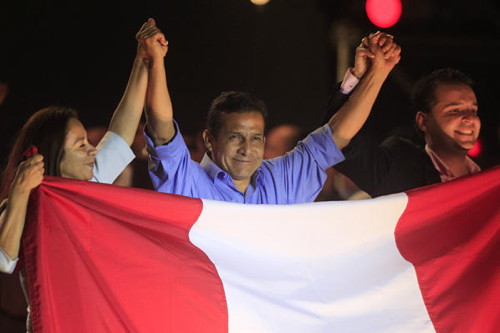
(above) Peru's president-elect Ollanta Humala, center, raises hands with his running mates First Vice President Marisol Espinoza, left, and Second Vice President Omar Chehade after the presidential runoff election in Lima, Peru, Sunday June 5, 2011. (Martin Mejia/AP)
Peru Election in pictures (15) from April 2011
(Click on picture)
Peru presidential victor Humala faces balancing act
June 6, 2011 - Christian Science Monitor
After edging out Keiko Fujimori in one of the tightest elections in the country's history, Ollanta Humala will try to help the poorest Peruvians while still maintaining Peru's economic growth.
By Lucien Chauvin, Correspondent
Lima, Peru
Ollanta Humala, a retired military officer, was elected president of Peru on Sunday. Humala's victory means a leftward shift in Peruvian policies, though he claims his model will not emulate Venezuela, as his critics fear.
Mr. Humala defeated Congresswoman Keiko Fujimori in one of the closest races in the country’s history, receiving slightly more than 51 percent of the votes with 88 percent of the vote counted. The tightest race before this contest was in 2006, when Humala lost to current President Alan Garcia by five points.
Humala won 17 of the country’s 26 regions, including massive victories in the southern highlands, coming close to 80 percent in several highly populated departments. Ms. Fujimori won in nine departments. Her most important victory was in Lima, the capital and home to one-third the population, where she scored a double-digit victory. She also carried the voter-rich northern coastal departments.
Humala now has to begin crafting an administration that will be closely watched by the business sector and much of the media, which were openly hostile to his candidacy, and supporters who voted for change in the economic model. It will not be easy.
“I voted for Humala, but I am still not sure,” said Edwin Lozada, a college student studying electrical engineering. “I agree with him that more people need to benefit from economic growth, but if he tries to do too much, things could get out of control and everyone will lose.”
Peru’s economy expanded by nearly 9 percent in the first quarter of this year, and the forecast for the full year is 7 percent, which is slower but will still gives the country one of the strongest growth rates in the world. Exports are growing at a record clip, inflation is within the three-point target for the year, and foreign reserves are close to $50 billion.
Humala won, despite these impressive numbers, because the vast majority of Peruvians – even those who voted for his opponent – do not feel that they have benefitted from 10 years of economic growth.
An antiestablishment election
Hernando de Soto, Peru’s best-known economist and a Fujimori adviser, said that Humala and Fujimori topped the first round of voting in April and competed in Sunday's runoff because average Peruvians want a larger slice of economic growth.
“The two antiestablishment candidates won in April because government policies have not favored the poorest. The past two administrations were caretaker governments, watching only macroeconomic numbers. This is what has led to so much social resentment in the country,” Mr. de Soto said.
Humala’s initial platform called for a much greater state role in the economy in order to distribute the benefits of growth and address the resentment. One plank talks about electricity, water, and natural resources, most of which are run by private companies, as “strategic activities that will be put to use to develop the nation and Peruvians.”
This kind of language terrified the country’s elites and foreign investors, who feared Humala meant to replicate Hugo Chávez’s model in Venezuela. Humala’s opponents painted him as a Chávez clone when he first ran for president in 2006. It worked and he lost. Humala has been distancing himself from Mr. Chávez ever since, and told foreign reporters two days before the vote that the Venezuelan economic and political model was not for Peru.
While not changing his platform, Humala announced two additional plans, a "commitment to Peru" and "roadmap for progress" that he said complemented it. The road map, presented in May, was much less ambitious than his original platform and included a pledge not to change the fundamentals of Peru's economic model.
Many remained unconvinced, as his razor-thin margin of victory shows. “Humala sounds too much like Chávez. I don’t think his ideas are what Peru needs if we are to continue to grow,” said Roque Gonzales after casting his ballot in a neighborhood in southern Lima.
Economic concerns already
The political give-and-take began immediately after the vote ended and exit polls pointed to a victory by Humala. Opponents in Congress called for Humala to quickly name an economic team to guarantee stability during the seven-week transition period before his inauguration on July 28.
Pedro Pablo Kuczynski, a former finance minister who came in third behind Humala and Fujimori in the April vote, echoed the call for Humala to set up his economic team, as Mr. Kuczynski predicted a big devaluation of Peru’s currency and drop in the local stock exchange in the days following the vote.
But Congressman Daniel Abugattas, a close Humala advisor, said there will be no rushing into things. He said the stock market might be down at the start of the week, but it will bounce back strong in a few days. “We are not offering anything radical,” he said.
